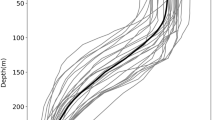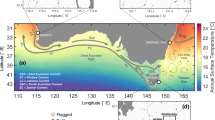Abstract
Oceanographic climatology is normally estimated by dividing the world’s oceans into geographical boxes of fixed shape and size, where each box is represented by a climatological salinity and temperature profile. The climatological profile is typically an average of historical measurements from that region. Since an arbitrarily chosen box may contain different types of water masses both in space and time, an averaged profile may be a statistically improbable or even non-physical representation. This paper proposes a new approach that employs empirical orthogonal functions in combination with a clustering technique to divide the world’s oceans into climatological regions. Each region is represented by a cluster that is determined by minimising the variance of the state variables within each cluster. All profiles contained in a cluster are statistically similar to each other and statistically different from profiles in other clusters. Each cluster is then represented by mean temperature and salinity profiles and a mean position. Methods for estimating climatological profiles from the cluster information are examined, and their performances are compared to a conventional method of estimating climatology. The comparisons show that the new methods outperform conventional methods and are particularly effective in areas where oceanographic fronts are present.












Similar content being viewed by others
References
Bearman G (ed) (1997) Seawater: its composition, properties and behaviour. Open University
Bunkers MJ Jr, JRM , Degaetand AT (1996) Definition of climate regions in the northern plains using an objective cluster modification technique. vol 9
Chen CT, Millero FJ (1977) Speed of sound in seawater at high pressures. J Acoust Soc Am 62:1129–1135
Finette S (2006) A stochastic representation of environmental uncertainty and its coupling to acoustic wave propagation in ocean waveguides. J Acoust Soc Am 120:2567–2579
Fraley C, Raftery AE (1998) How many clusters? Which clustering method? Answers via model-based cluster analysis. Comput J 41(8):578–588
Hjelmervik KT, Jensen JK, Østenstad P, Ommundsen A (2012) Classification of acoustically stable areas using empirical orthogonal functions. Ocean Dyn 62:253–264. doi:10.1007/s10236-011-0499-z
Iselin COD (1936) A study of the circulation of the western North Atlantic. Pap Phys Oceanogr Meteorol 4:101
Jensen FB, Kuperman WA, Porter MB, Schmidt H (2000) Computational ocean acoustics. Springer, New York
Jensen JK, Hjelmervik KT, Østenstad P (2012) Finding acoustically stable areas through empirical orthogonal function (EOF) classification. IEEE J Ocean Eng 37(1):103–111
LeBlanc LR, Middleton FH (1980) An underwater acoustic sound velocity data model. J Acoust Soc Am 67(6):2055–2062
LePage K (2006) Modeling propagation and reverberation sensitivity to oceanographic and seabed variability. IEEE J Ocean Eng 31:402–412
Levitus S (ed) (2010a) World Ocean Atlas 2009, vol. 1: temperature. U.S. Government Printing Office, Washington
Levitus S (ed) (2010b) World Ocean Atlas 2009, vol. 2: salinity. U.S. Government Printing Office, Washington
McCartney MS, Mauritzen C (2001) On the origin of the warm inflow to the nordic seas. Prog Oceanogr 51:125–214
Milligan SD, LeBlanc LR, Middleton FH (1978) Statistical grouping of acoustic reflection profiles. J Acoust Soc Am 64(3):795–807
Mork M (1981) Circulation phenomena and frontal dynamics of the norwegian coastal current. Philos Trans R Soc Lond Ser A Math Phys Sci 302(1472):635–647
Preisendorfer RW (1988) Principal component analysis in meteorology and oceanography. Elsevier, New York
Press WH, Teukolsky SA, Vetterling WT, Flannery BP (2007) Numerical recipes, 3rd edn. Cambridge University Press, New York
Therrien CW (1992) Discrete random signals and statistical signal processing. Prentice-Hall, Upper Saddle River
Ullman DS, Cornillon PC (1999) Satellite-derived sea surface temperature fronts on the continental shelf off the northeast U.S. coast. J Geophys Res 104(C10):23,459–23,478
Author information
Authors and Affiliations
Corresponding author
Additional information
Responsible Editor: Pierre Garreau
This article is part of the Topical Collection on the 16th biennial workshop of the Joint Numerical Sea Modelling Group (JONSMOD) in Brest, France 21–23 May 2012
Rights and permissions
About this article
Cite this article
Hjelmervik, K.T., Hjelmervik, K. Estimating temperature and salinity profiles using empirical orthogonal functions and clustering on historical measurements. Ocean Dynamics 63, 809–821 (2013). https://doi.org/10.1007/s10236-013-0623-3
Received:
Accepted:
Published:
Issue Date:
DOI: https://doi.org/10.1007/s10236-013-0623-3




